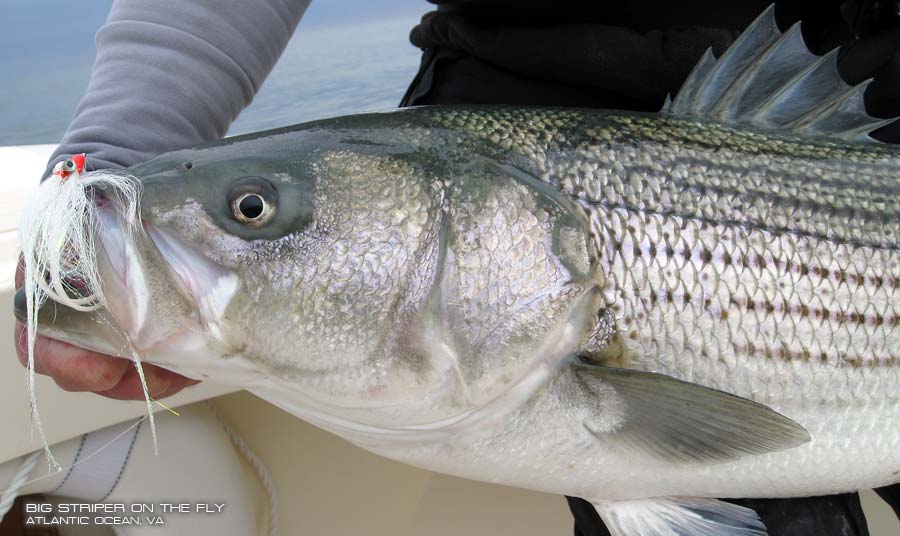
The Striped Bass, scientifically referred to as Morone saxatilis, known in the Chesapeake Bay region as Striper, Rockfish, Linesider, Roller, Squidhound and in the northern Atlantic states simply as “Bass,” is one of the most avidly pursued of all coastal sport fish. Striped Bass are native to most of the East Coast, ranging from the lower St. Lawrence River in Canada to the St. John's River in Northern Florida, and from Lake Pontchartrain, Louisiana on the Gulf of Mexico to the open waters of the Atlantic. The primary range where most recreational and commercial anglers along the east coast pursue striped bass spans from Maine to North Carolina. However, Striped Bass are also found in many freshwater inland lakes along the east coast. The west coast of the United States also has a healthy striped bass fishery, mainly in the Delta area of northern California. While the east and west coast striped bass fisheries draw the most attention, striped bass can be found in 31 states, facilitated by stocking programs in lakes and reservoirs.
The striped bass has been a prized fish since colonial times. In 1670, Plymouth Colony established a free school with income from coastal striped bass fisheries, making one of the first public schools in America supported by this highly valued resource. The unique angling qualities of this trophy species and its adaptability to fresh water environments have led to a major North American range expansion within the last 100 years, and have led to the striped bass being one of the top species pursued in North America.
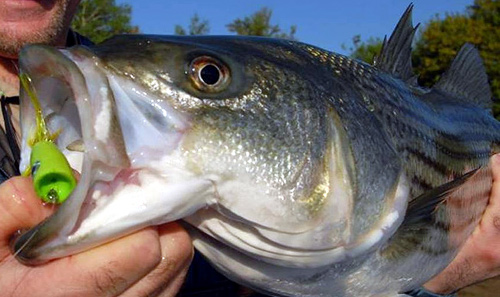 Distinguishing Characteristics of Striped Bass Distinguishing Characteristics of Striped Bass
Several characteristics distinguish the striper from other fish found along the east coast. The striped bass has a large mouth, with jaws extending backward to below the eye. It has two prominent spines on the gill covers. The first (most anterior) of its two well-developed and separated dorsal fins possesses a series of sharp, stiffened spines. The anal fin, with its three sharp spines, is about as long as the posterior dorsal fin. The striped bass’ upper body variously appears as a light green, olive, steel blue, brown or black depending on the ecosystem in which it lives. They earn their name from the seven or eight continuous stripes, one of which is the striped bass’ lateral line, which marks their silvery sides, extending from the gills to the tail. Their undersides are usually white or silver, with a brassy iridescence.
History of Striped Bass
In 1607, Captain John Smith found the Chesapeake Bay waters clean and clear, free of the phytoplankton clouds that followed in later years. He wrote in 1614 that the fish seemed so plentiful that one might walk “dryshod” across their backs over the river. In 1634, William Wood’s “New England Project,” using seine nets, captured thousands of the fish at a catch; the bass were salted and used for winter stores, and as fertilizer for agricultural purposes.
By 1639, the state of Massachusetts, observing the fishery significantly depleted due to overfishing and poor water quality, forbade the use of the fish as fertilizer. This bold first step led to the first environmental impact statement and the eventual passage of the National Environmental Policy Act in 1969, the precursor to Magnuson-Stevens and regional fisheries legislation.
In the late 1800s, Dr. Livingston Stone of the United States Fish Commission (a forerunner of U.S. Fish and Wildlife), at the urging of the California State Board of Fish Commissions, began transporting the bass from New Jersey to the San Francisco Bay. In milk cans and wooden barrels, first hand agitated and refreshed, later afforded a crude oxygenation system, the first stripers made their way to the west coast. The striper is now one of California’s top ranking sport fish. Found in relative abundance in the early 1900s, the fish numbered approximately three million adults in the early 1960s; by the early 1990s, the count was about 775 thousand, with 30% of those hatchery-reared. Still fished as far as the Columbia River in Washington State, the Sacramento Delta fishery, where the fish migrate bi-annually, remains troubled by Delta water diversions, pollution, illegal take, exotic aquatic organisms, and Bay-fill projects. Last-ditch efforts are being made to restore the western fisheries.
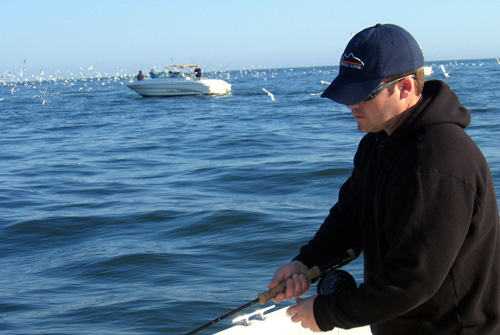 The Decline of Striped Bass on the East Coast The Decline of Striped Bass on the East Coast
The record commercial catch in 1973 reported 14.7 million pounds. By 1983, the fishery catch reported was 1.7 million pounds. Ensuing moratoriums resulted in huge loss of jobs and revenue. The Atlantic Striped Bass Conservation Act in 1984, in addition to moratorium legislation in Virginia, Maryland, Delaware, and Pennsylvania produced some positive result, but the poor condition of the Chesapeake Bay, from overfishing, mercury emissions, agricultural runoff, and the environmental impact of poultry farms, generally outweighed the effort. By 2006, Maryland numbers saw anglers exceeding quotas by 60%, with an estimated catch of over 67K fish in the four-week season; unexplained fish kills in the Susquehanna River added to the conservationists’ frustration. In response, the minimum size of legal catch was increased and tournaments were banned during spawning season.
The Moratorium in the Chesapeake Bay
In 1985, in response to the collapse of the fishery in the 80s, Maryland and Delaware imposed a moratorium on striped bass fishing altogether; the Virginia and Potomac River Fisheries Commissions followed in 1989. The moratorium, lifted in 1990, was a relative success. Striped Bass stock has been rebuilt and is maintained by monitoring, quotas, and seasonal closings, yet is still plagued by ecosystem health concerns.
Striped Bass Life Cycle
Striped bass can live up to forty years and reach weights greater than 100 pounds at nearly five feet in length, although individuals larger than 50 pounds are considered an absolute trophy fish and a possibly once-in-a-lifetime. The all-tackle angling record fish, taken in New Jersey in 1982, weighed 78 ½ pounds.
The following table lists average lengths and weights of striped bass at selected ages. I used several sources (scientific data, my own records and fellow angler records) of weight to length ratio data and combined them into an excel sheet. I then analyzed the data and came up with my best approximation of an accurate weight to length chart. All the striped bass were taken somewhere along the east coast (Northeast to Virginia), either in the ocean, Chesapeake Bay or a tributary of the Chesapeake Bay. Please do not rely upon this chart as an absolute, but rather as a general guideline in your effort to estimate weight based on size measurements.
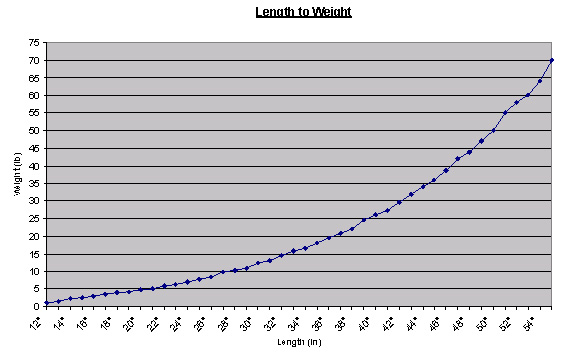
Females reach significantly greater sizes than do males; most stripers over thirty pounds are female. Thus, the term "bulls," originally coined to describe extremely large individuals, has been more accurately changed to "cows" in recent times. Males rarely live over ten years, while females can reach ages of nearly 20 years on occasion. The number of eggs produced by a female striped bass is directly related to the size of its body; a 12-pound female may produce about 850,000 eggs, and a 55-pound female about 4,200,000 eggs. Females mature no earlier than four years, and some not until six or eight. By contrast, most males reach sexual maturity at two or three years of age.
The size of the females at sexual maturity has generally been used as a criterion for establishing minimum legal size limit regulations in recent years along the east coast.
Spawning Striped Bass along the Atlantic Coast and Chesapeake Bay/Striped Bass Migration
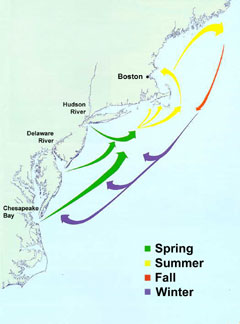 The migratory behaviors of coastal striped bass are more complex than those of most other anadromous fish, which spend most of their adult lives in the ocean but migrate up rivers and streams to spawn. Striped Bass seasonal movements depend upon the age, sex, degree of maturity and the river in which they were born. At one time the Chesapeake Bay and its tributaries were responsible for as much as 90% of the spawning ground for the Atlantic Striped Bass population. While the Chesapeake Bay remains the primary location for spawning activity and nursery area for the east coast Striped Bass population (scientists estimate the Chesapeake Region accounts for between 70-90%), spawning activity also occurs in the Roanoke River/Albemarle Sound watershed in North Carolina and the Hudson River in New York. Some spawning activity has been witnessed in the Delaware River and several smaller river systems along the east coast. It is widely believed that these river systems, as long as pollution is kept to a minimum, will continue to expand in spawning areas. In late winter mature striped bass begin to move from the Atlantic Ocean into tidal freshwater to spawn. Spawning is triggered by an increase in water temperature as well as salinity levels and generally occurs in April, May and early June in the Chesapeake Bay tributaries, Roanoke River and Hudson River. Scientists believe that young striped bass do best at a salinity of about 0.6 to 11 parts per thousand, compared to full strength seawater which has a salinity of about 34 parts per thousand. Striped Bass have an innate sense of finding the right water before spawning. The migratory behaviors of coastal striped bass are more complex than those of most other anadromous fish, which spend most of their adult lives in the ocean but migrate up rivers and streams to spawn. Striped Bass seasonal movements depend upon the age, sex, degree of maturity and the river in which they were born. At one time the Chesapeake Bay and its tributaries were responsible for as much as 90% of the spawning ground for the Atlantic Striped Bass population. While the Chesapeake Bay remains the primary location for spawning activity and nursery area for the east coast Striped Bass population (scientists estimate the Chesapeake Region accounts for between 70-90%), spawning activity also occurs in the Roanoke River/Albemarle Sound watershed in North Carolina and the Hudson River in New York. Some spawning activity has been witnessed in the Delaware River and several smaller river systems along the east coast. It is widely believed that these river systems, as long as pollution is kept to a minimum, will continue to expand in spawning areas. In late winter mature striped bass begin to move from the Atlantic Ocean into tidal freshwater to spawn. Spawning is triggered by an increase in water temperature as well as salinity levels and generally occurs in April, May and early June in the Chesapeake Bay tributaries, Roanoke River and Hudson River. Scientists believe that young striped bass do best at a salinity of about 0.6 to 11 parts per thousand, compared to full strength seawater which has a salinity of about 34 parts per thousand. Striped Bass have an innate sense of finding the right water before spawning.
Shortly after spawning, mature fish return to the coast. Most spend summer and early fall months in middle New England near-shore waters. In late fall and early winter they migrate south to the North Carolina and Virginia capes.
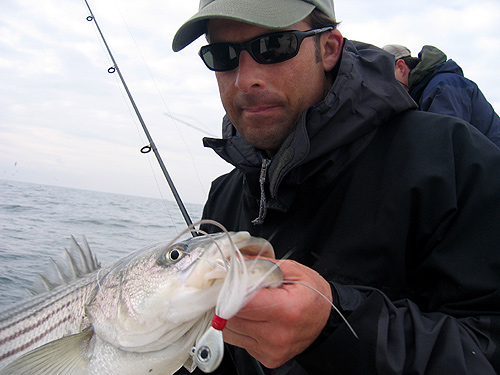 Habitat and Food Web Habitat and Food Web
After spawning, the eggs are transported downstream; the bass larvae require adequate turbulence, provided by moving water, to enable them to remain suspended in the oxygen-rich region of the water column. Without the moving water, sinking to the bottom, the egg is rendered non-vital by sediments, which deprives them of the oxygen exchange necessary for survival. There is therefore no natural reproduction in reservoirs and lakes; state fishery departments stock the fish in these waters.
The larvae feed primarily on zooplankton and water fleas. After the hatch, the quarter-inch fish are attached to a heavy yolk sac, which provides them necessary nourishment for four or five days. The fry then begin to feed on small crustaceans. As they grow, their diet expands to include insect larvae, other larval fish, mysids, and amphipods. Adults are piscivorous, existing primarily on shad. Striped Bass have been known to eat anything that swims, crawls or floats, even its own kind. Mature Striped Bass prefer Menhaden, Silversides, and Anchovies and during the summer months in the Chesapeake Bay they focus on Spot and Croaker. Approximately 95 percent of the Striped Bass diet comes from other finfish. The optimal feeding range is 55 to 68 degrees Fahrenheit, but feeding occurs between 40 and 75 degrees.
|

![]()

 Distinguishing Characteristics of Striped Bass
Distinguishing Characteristics of Striped Bass The Decline of Striped Bass on the East Coast
The Decline of Striped Bass on the East Coast
 The migratory behaviors of coastal striped bass are more complex than those of most other anadromous fish, which spend most of their adult lives in the ocean but migrate up rivers and streams to spawn. Striped Bass seasonal movements depend upon the age, sex, degree of maturity and the river in which they were born. At one time the Chesapeake Bay and its tributaries were responsible for as much as 90% of the spawning ground for the Atlantic Striped Bass population. While the Chesapeake Bay remains the primary location for spawning activity and nursery area for the east coast Striped Bass population (scientists estimate the Chesapeake Region accounts for between 70-90%), spawning activity also occurs in the Roanoke River/Albemarle Sound watershed in North Carolina and the Hudson River in New York. Some spawning activity has been witnessed in the Delaware River and several smaller river systems along the east coast. It is widely believed that these river systems, as long as pollution is kept to a minimum, will continue to expand in spawning areas. In late winter mature striped bass begin to move from the Atlantic Ocean into tidal freshwater to spawn. Spawning is triggered by an increase in water temperature as well as salinity levels and generally occurs in April, May and early June in the Chesapeake Bay tributaries, Roanoke River and Hudson River. Scientists believe that young striped bass do best at a salinity of about 0.6 to 11 parts per thousand, compared to full strength seawater which has a salinity of about 34 parts per thousand. Striped Bass have an innate sense of finding the right water before spawning.
The migratory behaviors of coastal striped bass are more complex than those of most other anadromous fish, which spend most of their adult lives in the ocean but migrate up rivers and streams to spawn. Striped Bass seasonal movements depend upon the age, sex, degree of maturity and the river in which they were born. At one time the Chesapeake Bay and its tributaries were responsible for as much as 90% of the spawning ground for the Atlantic Striped Bass population. While the Chesapeake Bay remains the primary location for spawning activity and nursery area for the east coast Striped Bass population (scientists estimate the Chesapeake Region accounts for between 70-90%), spawning activity also occurs in the Roanoke River/Albemarle Sound watershed in North Carolina and the Hudson River in New York. Some spawning activity has been witnessed in the Delaware River and several smaller river systems along the east coast. It is widely believed that these river systems, as long as pollution is kept to a minimum, will continue to expand in spawning areas. In late winter mature striped bass begin to move from the Atlantic Ocean into tidal freshwater to spawn. Spawning is triggered by an increase in water temperature as well as salinity levels and generally occurs in April, May and early June in the Chesapeake Bay tributaries, Roanoke River and Hudson River. Scientists believe that young striped bass do best at a salinity of about 0.6 to 11 parts per thousand, compared to full strength seawater which has a salinity of about 34 parts per thousand. Striped Bass have an innate sense of finding the right water before spawning. Habitat and Food Web
Habitat and Food Web